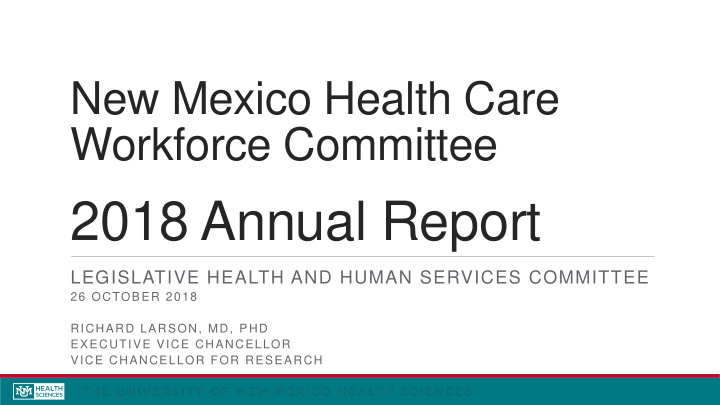



New Mexico Health Care Workforce Committee 2018 Annual Report LEGISLATIVE HEALTH AND HUMAN SERVICES COMMITTEE 26 OCTOBER 2018 RICHARD LARSON, MD, PHD EXECUTIVE VICE CHANCELLOR VICE CHANCELLOR FOR RESEARCH
OVERVIEW Background Update on previous recommendations Update on provider supply Special issues and recommendations in behavioral health 2018 recommendations
BACKGROUND In 2012 HB19 – the Health Care Work Force Data Collection, Analysis and Policy Act – became law and the following occurred: Licensure boards are required to develop surveys on practice characteristics. Licensure data was directed to UNM HSC for stewardship and storage. The establishment of the New Mexico Health Workforce Committee, to include state-wide constituents. The Committee is required to evaluate workforce needs and make recommendations.
ACCOMPLISHMENTS SINCE 2013 Instrumental in enhancing funding for: Health professionals loan repayment program Nursing education expansion Allied Health Loan for Service expansion State-funded residency positions GME funded positions Health care workforce financial aid Other impacts Telehealth services (Project ECHO) Community Health Worker training
OUTCOMES OF 2017 RECOMMENDATIONS The NM Higher Education Department is to be commended for achieving reinstatement of the federal matching funds for the NM State Loan Repayment Program. The Board of Pharmacy and Regulation and Licensing Department are to be commended for promptly correcting the registered pharmacists’ survey. We reiterate the need for funding to support the New Mexico Nursing Education Consortium. We reiterate the need for continued funding of expanded primary and secondary care residencies, state loan-for-service and loan repayment programs, and the NM Health Care Workforce Committee.
HEALTH CARE WORKFORCE IN NEW MEXICO As of 31 December 2017, New Mexico has: 9,585 Licensed Physicians 5,498 Practice in New Mexico (57%) 2,360 Primary Care Physicians 282 Obstetrician/Gynecologists 194 General Surgeons 332 Psychiatrists 2,152 Certified Nurse Practitioners and Clinical Nurse Specialists 1,453 Practice in New Mexico (68%) Increase of 60 Physicians and 74 CNPs/CNSs since 2016 6
CHANGE OVER TIME: PHYSICIANS Profession 2013 2014 2015 2016 2017 Change Practicing in NM All MDs & DOs 4,926 5,367 5,438 5,498 + 572 PCPs 1,957 1,908 2,075 2,076 2,360 + 403 OB-GYNs 256 236 253 273 282 + 26 General Surgeons 179 162 177 188 194 + 15 Psychiatrists 321 289 302 332 332 + 11 Other Specialties 2,331 2,553 2,569 2,330 - 1
CHANGE OVER TIME: OTHER PROFESSIONS Profession Practicing in 2013 2014 2015 2016 2017 Change NM CNP/CNS 1,089 1,228 1,293 1,379 1,453 + 364 PA 694 698 746 792 + 98 No data CNM 156 178 + 22 No data No data No data LM 38 42 + 4 No data No data No data Dentists 1,081 1,131 1,171 1,215 + 134 No data Pharmacists 1,928 1,911 2,013 2,003 + 75 No data RN 15,713* 17,219 18,173 + 2,460 EMT 6,101 6,364 + 263 No data No data No data
PRIMARY CARE PHYSICIANS
OB-GYNs & PSYCHIATRISTS
REGISTERED NURSES
SHORTAGES As of 31 December 2017: Shortages are most severe in less-populated counties Without redistributing the current workforce, New Mexico needs: 126 Primary Care Physicians 11 CNMs 30 Obstetrics and Gynecology Physicians 4 LMs 12 General Surgeons 46 Dentists 111 Psychiatrists 258 Pharmacists 147 CNPs/CNSs 3,022 RNs 113 PAs 415 EMTs Average age is 53.5 years (national average: 51.3 years 1 ) Highest percentage of physicians over 60 years (37.0% versus 30.3% nationwide) 2 1 Physicians Foundation. 2016. 2016 Survey of America’s Physicians. www.physiciansfoundation.org 2 American Association of Medical Colleges. 2017. 2017 State Physician Workforce Data Book. Washington DC: AAMC.
BEHAVIORAL HEALTH IN NEW MEXICO It was not possible this year to analyze the behavioral health workforce in depth due to insufficient survey responses received from the Regulation and Licensing Department. Nonetheless, behavioral health workforce continues to be an important need for New Mexico, and providers cite the limitations of the workforce as the biggest barrier to providing quality behavioral health care in the state. NM continues to face severe behavioral health outcomes: Highest alcohol-related mortality rate in the US Suicide mortality rate 50% higher than national rate But when treatment is received, a higher proportion of patients report improved functioning as a result of treatment compared to the US average.
2018 RECOMMENDATIONS
2018 RECOMMENDATIONS: ALL HEALTH PROFESSIONS Identify funding for efforts to support NMNEC Direct RLD to correct their information technology system changes so that all survey responses can be provided to the UNM Health Sciences Center and the committee Continue funding for expanded primary and secondary care residencies in New Mexico Increase funding for state loan-for-service and loan repayment programs, and consider restructuring them to target most needed professions rather than highest debt
2018 RECOMMENDATIONS: ALL HEALTH PROFESSIONS Request that the Department of Health add pharmacists, social workers and counselors to the health care professions eligible for New Mexico’s Rural Healthcare Practitioner Tax Credit program Create a committee tasked with examining future health care workforce needs related to the state’s changing demographics Provide funding for the New Mexico Health Care Workforce Committee Establish a tax credit for health care professional preceptors who work with public institutions Direct the pertinent professional licensing boards to make the necessary changes to align their surveys with legislative requirements and other boards’ surveys
2018 RECOMMENDATIONS: BEHAVIORAL HEALTH Require that licensed behavioral health professionals receive three hours of continuing education credits each licensure cycle in the treatment of substance use disorders. Finalize and promulgate changes to the NM Medicaid Behavioral Health Regulations: To reimburse Medicaid services when delivered by behavioral health interns in community settings. To identify PAs as a behavioral health provider type which will allow Medicaid reimbursement of services when delivered by PAs in behavioral health settings. Expedite direct services via telehealth by participating in the PSYPACT interstate licensing compact. Fund and infrastructure through the NM Hospital Association for a centralized Telebehavioral Health Program to provide direct care to rural communities.
QUESTIONS? RICHARD LARSON, MD, PHD RLARSON@SALUD.UNM.EDU
Recommend
More recommend